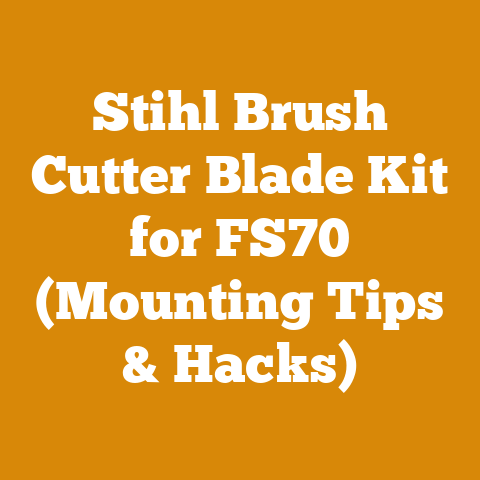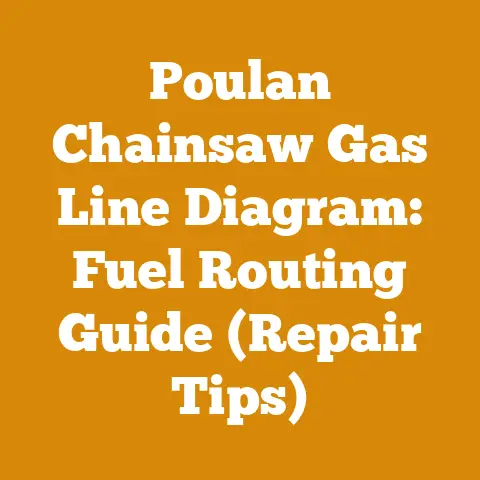Husqvarna Chainsaw Changing Chain Tips (5 Pro Hacks)
Husqvarna Chainsaw Changing Chain Tips (5 Pro Hacks)
Let’s face it, the roar of a chainsaw can be music to some ears (mine included!), but the screech of a dull chain is a symphony of frustration. As someone who’s spent countless hours felling trees and processing wood, I know firsthand the importance of a sharp, properly installed chain. A dull chain not only makes your work harder, but it’s also a significant safety hazard. That’s why I want to share my top five pro hacks for changing the chain on your Husqvarna chainsaw quickly, efficiently, and safely. These tips will save you time, prevent injuries, and ensure your chainsaw performs at its peak.
Introduction: Noise Reduction and the Importance of a Sharp Chain
Before we dive into the nitty-gritty of chain replacement, let’s talk about something often overlooked: noise. A dull chain forces your chainsaw to work harder, generating more noise and vibration. This not only contributes to operator fatigue but also increases the risk of hearing damage. A sharp chain, on the other hand, slices through wood effortlessly, reducing both noise and vibration. Think of it like this: a sharp knife glides through a tomato, while a dull one squashes it. The same principle applies to chainsaw chains.
I remember one particularly long day felling oak trees for firewood. My chain had dulled significantly, and I was pushing the saw harder and harder. The noise was deafening, and my hands were numb from the vibration. By the end of the day, I had a splitting headache and felt completely drained. That experience taught me a valuable lesson: maintaining a sharp chain is not just about efficiency; it’s about preserving your health and well-being.
Hack #1: Master the Husqvarna Chain Brake
One of the first things I teach anyone using a chainsaw is the importance of the chain brake. This safety feature is designed to stop the chain instantly in case of kickback or loss of control. Before you even think about changing your chain, engage the chain brake. This simple step can prevent serious injuries.
- How it works: The chain brake is a lever located in front of the top handle. Pushing it forward engages the brake, stopping the chain. Pulling it back releases the brake, allowing the chain to rotate.
- Why it’s crucial: Even with the engine off, the chain can still move slightly due to residual momentum. The chain brake ensures the chain remains stationary during the chain replacement process.
- My experience: I once witnessed a close call where a chainsaw chain unexpectedly moved while someone was attempting to adjust it. Thankfully, the chain brake was engaged, preventing a potential injury.
Takeaway: Always engage the chain brake before changing your chainsaw chain. No exceptions.
Hack #2: Understand Your Husqvarna Chain Specifications
Husqvarna chainsaws come in various models, each requiring a specific chain type. Using the wrong chain can damage your chainsaw and compromise its performance. Before you buy a new chain, take the time to understand your chainsaw’s specifications.
- Pitch: The pitch is the distance between any three consecutive rivets divided by two. Common pitches include .325″, 3/8″, and .404″.
- Gauge: The gauge is the thickness of the drive links that fit into the guide bar groove. Common gauges include .050″, .058″, and .063″.
- Drive Links: The number of drive links determines the chain’s length and ensures it fits properly on the guide bar.
I learned this lesson the hard way. I once purchased a chain that I thought was the correct size, only to discover that the gauge was slightly off. The chain was too loose on the guide bar, causing excessive vibration and making it difficult to make clean cuts.
- Finding the specifications: The chain specifications are usually printed on the guide bar or in the chainsaw’s user manual. You can also find this information on the Husqvarna website by entering your chainsaw model number.
- Using a chain gauge tool: A chain gauge tool is a handy device that allows you to quickly and accurately measure the pitch and gauge of your chain. These tools are inexpensive and can save you a lot of headaches.
- My recommendation: Always double-check the chain specifications before making a purchase. It’s better to be safe than sorry.
Takeaway: Know your Husqvarna chainsaw’s chain specifications (pitch, gauge, and drive links) before buying a new chain.
Hack #3: Streamline the Chain Removal Process
Removing the old chain can sometimes be a bit tricky, especially if it’s worn or damaged. Here’s how I streamline the process:
- Loosen the bar nuts: Use the wrench that came with your chainsaw to loosen the bar nuts that hold the guide bar cover in place. Don’t remove the nuts completely; just loosen them enough to allow the cover to move.
- Adjust the chain tension: Most Husqvarna chainsaws have a chain tensioning mechanism located on the side of the saw. Use the wrench or a screwdriver to loosen the tension on the chain. This will make it easier to remove the chain from the guide bar.
- Remove the guide bar cover: Once the bar nuts are loose and the chain tension is reduced, carefully remove the guide bar cover.
- Remove the old chain: Gently lift the old chain off the guide bar, starting at the top. Be careful not to cut yourself on the sharp teeth.
-
Inspect the guide bar: Before installing the new chain, inspect the guide bar for wear and damage. Look for burrs, uneven wear, or cracks. If the guide bar is damaged, replace it. I’ve seen guide bars that have been severely damaged due to improper chain tension or lack of lubrication.
-
Pro Tip: I often use a small screwdriver or a specialized chain removal tool to help lift the chain off the guide bar. These tools can be particularly useful when dealing with tight or damaged chains.
- My approach: I always wear gloves when handling chainsaw chains. This protects my hands from cuts and keeps them clean.
Takeaway: Loosen the bar nuts, adjust the chain tension, and carefully remove the old chain. Inspect the guide bar for wear and damage.
Hack #4: Master the Art of Chain Installation
Installing the new chain correctly is crucial for optimal performance and safety. Here’s my step-by-step guide:
- Position the guide bar: Place the guide bar back onto the chainsaw, ensuring that it is properly seated on the mounting studs.
- Orient the chain correctly: Make sure the cutting teeth on the chain are facing in the correct direction. The cutting teeth should point forward on the top of the guide bar. This is a common mistake that can prevent the chainsaw from cutting properly.
- Install the chain: Starting at the top of the guide bar, carefully loop the chain around the sprocket and into the groove of the guide bar. Ensure that the drive links are properly seated in the groove.
- Adjust the chain tension: Use the chain tensioning mechanism to adjust the tension on the chain. The chain should be snug but still able to be pulled around the guide bar by hand.
- Replace the guide bar cover: Place the guide bar cover back onto the chainsaw and tighten the bar nuts.
- Final tension check: After tightening the bar nuts, double-check the chain tension. The chain should still be able to be pulled around the guide bar by hand, but there should be no excessive slack.
I always make sure to lubricate the chain with chainsaw oil before starting the engine. This helps to reduce friction and prolong the life of the chain.
- Pro Tip: I find it helpful to use a chain installation tool to assist with guiding the chain onto the guide bar. These tools can be particularly useful when dealing with tight chains.
- My insight: Pay close attention to the direction of the cutting teeth. This is a common mistake that can prevent the chainsaw from cutting properly.
Takeaway: Orient the chain correctly, install it properly, adjust the chain tension, and double-check everything before starting the engine.
Hack #5: Chain Tensioning: The Goldilocks Principle
Getting the chain tension just right is crucial for safety and performance. Too loose, and the chain can derail. Too tight, and it can overheat and break. The goal is to find the “just right” tension – the Goldilocks principle.
- The “Pull-Around” Test: After installing the chain and tightening the bar nuts, I perform the “pull-around” test. With the chain brake engaged, I use my gloved hand to gently pull the chain around the guide bar. The chain should move freely without excessive slack.
- The “Finger Test”: Another method I use is the “finger test.” I gently lift the chain away from the guide bar in the middle. There should be a small gap, about the thickness of a dime.
- Adjusting for Temperature: Keep in mind that the chain will expand as it heats up during use. Therefore, it’s best to slightly loosen the chain tension when it’s cold.
-
Monitoring Chain Tension During Use: I regularly check the chain tension during use, especially when working with hardwoods or in hot weather. If the chain becomes too loose, I stop the saw and adjust the tension as needed.
-
My experience: I once had a chain derail while felling a large oak tree. The chain was too loose, and it jumped off the guide bar, narrowly missing my leg. That experience taught me the importance of maintaining proper chain tension.
- Pro Tip: Always refer to your Husqvarna chainsaw’s user manual for specific chain tensioning recommendations.
Takeaway: Use the “pull-around” test and the “finger test” to ensure proper chain tension. Adjust for temperature and monitor chain tension during use.
Bonus Tip: Regular Chain Sharpening
While this guide focuses on changing the chain, remember that regular chain sharpening is essential for maintaining optimal performance and safety. A sharp chain cuts faster, reduces vibration, and is less likely to kick back.
- Using a Chainsaw File: I use a round chainsaw file to sharpen my chains regularly. This is a simple and effective way to keep the chain sharp.
- Using a Chainsaw Sharpener: For more precise sharpening, I use a chainsaw sharpener. These tools can help you maintain the correct angle and depth of the cutting teeth.
- Professional Sharpening: If you’re not comfortable sharpening your own chains, you can take them to a professional sharpening service.
I recommend sharpening your chain every time you refuel your chainsaw. This will help to keep the chain sharp and prevent it from becoming dull.
Conclusion: A Sharp Chain, A Safer Job
Changing the chain on your Husqvarna chainsaw is a crucial maintenance task that can significantly impact performance, safety, and the overall enjoyment of your work. By mastering these five pro hacks, you’ll be able to replace your chain quickly, efficiently, and safely, ensuring that your chainsaw is always ready to tackle any wood processing challenge. Remember, a sharp chain is a safer chain, so take the time to maintain your equipment and prioritize your safety. Now, get out there and make some sawdust!






